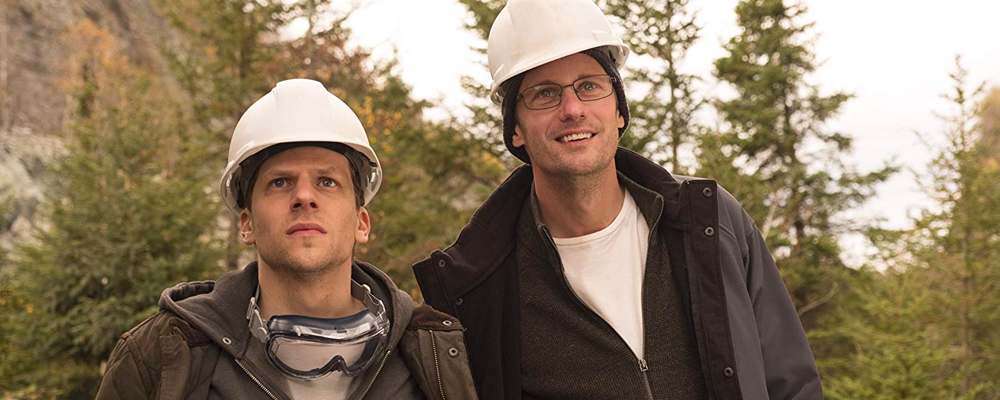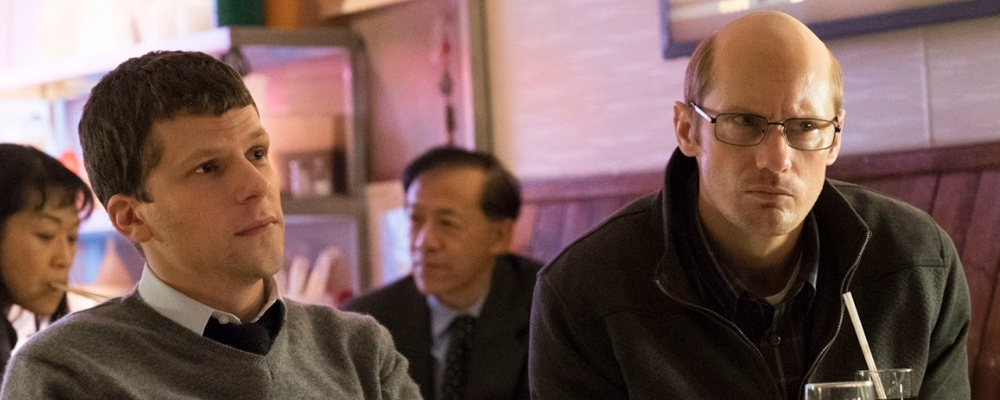‘The Hummingbird Project’: Wall Street, Fiber Optics and the Pursuit of Money
Michael Amundsen
Yearly, the best and brightest scientific minds are recruited out of the top universities and paid big bucks for the single purpose of creating ways to make Wall Street trading firms richer. Writer/director Kim Nguyen explores the logistics, ambition and morality behind Wall Street’s greed in his latest feature film, “The Hummingbird Project.”
Jesse Eisenberg stars as Vincent Zaleski, a first generation American. Zaleski talks his brilliant but socially awkward cousin Anton (Alexander Skarsgård, looking not at all like his usual Nordic God self) into assisting in him in a wild scheme to lay hundreds of miles of fiber-optic cable between Kansas City and New Jersey in a straight line through private properties, Granite Mountains and National Forests. And all of this effort is for the possibility of shaving a millisecond or two off of delivery times in the high-stakes game of high-frequency trading.
Opposing their plans is their coldly ambitious former boss, Eva Torres (Salma Hayek, also not readily recognizable). Conflicted between her pain of their betrayal and her desire to make more money, she does all she needs to do to stay one step ahead of the cousins.
Michael Mando plays Mark Vega, the contractor charged with making Vincent’s pipe dream a reality. Vega is the voice of sensibility and sanity in Vincent’s crazy world.
“The Hummingbird Project” is a fast-paced technological thriller of one man’s evolution as his ambition robs him of his humanity.
Entertainment Voice spoke with writer/director Kim Nguyen about twenty ton earth diggers, fiber optic cables the size of a human hair and the worth of capitalistic greed.
“That’s the point of the film,” said Nguyen. “It’s all for a tiny millisecond. And that is where the brains are working nowadays. Because that’s where the money is: shaving a couple of milliseconds off their transactions. It takes a lot of brainpower that’s being sucked out the great potential of making our world a better place. Instead they are using it to shave a couple of milliseconds or find a backdoor to get an edge on the stock market. Quite unfortunate.”
The strength of the film is how Nguyen is able to take a complex subject like fiber optics and data transfers, and use it to tell a story simple enough to hold any audience. The rich humanity of the narrative is never bogged down with a large weight of exposition.
Nguyen believes the morality of his characters was foremost in his mind as he began to write the screenplay. Writing the technical details of a subject new to him became one of his biggest challenges. As he wrote, he was just as likely to create realities as he was to rely on research.
“I read up a little bit on fiber optics but when it came to writing what the cousins had to go through, I just wrote the story as if they were digging a normal tunnel, and invented and fantasized stuff like what if you were in front of a big concrete mountain? OK, what do you do? You’d probably have stuff explode and machines that would drill through things. And it would come up on Google.”
“I wrote just enough that would attract actors and financiers, but before it went into pre-production, I knew it was full of lies.”
“Then I brought in the experts and said, ‘Okay, I have written about this little black box, and is there something like this and what does it do and what is it called? And it was really weird that most of the time there really was such a device. Often it was very different, but it fit somehow.”
“Realizing how fiber optic is not much bigger than a single strand of hair, And then to realize that to be able to pull fiber like that for a thousand miles without any failure is really a daunting task. And you don’t realize how really daunting those twenty ton machines are until you work with them.”
To Nguyen, the most important part of the story was its humanity. Finding the right cast was a key element of that.
“I am French/Canadian. Jesse (Eisenberg) really helped me out. He had that energy of a New Yorker and the son of recent immigrants. I am aware that Jesse blurts out a lot of information. It’s more of an aesthetic thing than an informational one. You understand that it’s complex, but you also understand that the point is to juxtapose his ambition with that other part of him who is realizing that he has another higher purpose.”
The casting of Alexander Skarsgård as Vincent’s awkward but brilliant cousin was an unexpected approach that required an active collaboration with the actor.
“I sent him a photograph of a bald trader in front of a computer screen, and he thought it was great. The problem was that the investors began to get worried I was going to destroy their beautiful Alexander. So we started talking about not cutting his hair and dialing back this nerdy image and Alex said, ‘No. Kim, I am supporting you and the character in the photo you sent.”
“You have actors that are not in this kind of film for the paycheck, but to do the best job that they can do.” Jesse, Alexander and Salma are those kind of actors.
In the movie, Vincent’s quest leads him over picturesque scenery and variable weather. But it was not the physical journey that shines out the most in Vincent’s quixotic quest. Nguyen is most interested in Vincent’s moral journey, a journey that begins in the high energy trading centers of Wall Street and ends in the muddy pastures of an Amish farm.
“I really liked the main character (Vincent) because as a director you are always wanting a balance between your insecurities and wanting to be respected and admired. I hope that in the process of making films, when it’s going the right way, it’s about freeing yourself of that need to be respected and all that, and just make a good film.”
“The Hummingbird Project” opens March 14 in select theaters.





